If you’ve ever wrestled with a heavy, tangled garden hose, you know how frustrating it can be. I myself have arthritis in my hands and it can be challenging. Enter expandable, coiled and other fabric hoses—a game changer for gardeners and homeowners alike. These innovative hoses are lightweight, easy to store, and can extend to great lengths. In this article, we’ll explore some of the best garden hoses on the market, highlighting their features, benefits, and what to consider before making a purchase.
*I may earn a commission at no additional cost to you. I only add products I believe in.
What is an Expandable Garden Hose?
Expandable garden hoses are made from durable materials that allow them to expand significantly when water flows through them. When empty, they contract to a fraction of their size, making them easy to store and handle. This design eliminates the hassle of traditional hoses, which can be heavy, bulky, and prone to kinking.
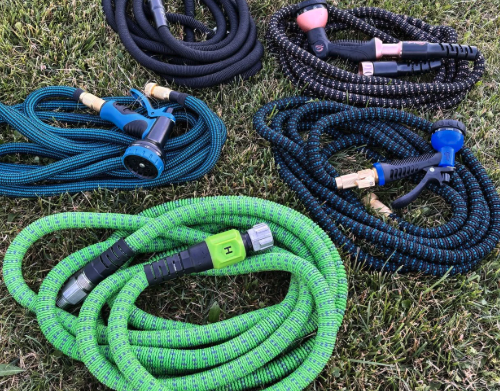
*I may earn a commission at no additional cost to you. I only add products I believe in.
Benefits of Using Expandable Garden Hoses
1. Lightweight and Portable: Expandable hoses are much lighter than traditional rubber or vinyl hoses, making them easy to maneuver around your garden or yard.
2. Space-Saving: Their ability to shrink in size means you can store them in small spaces, such as a garden shed or even in a drawer.
3. Kink-Resistant: Most expandable hoses are designed to minimize kinks and tangles, allowing for a smoother watering experience.
4. Durable Materials: Many models are made from high-quality, puncture-resistant materials that are built to last.
5. Variety of Lengths: Expandable hoses come in various lengths, allowing you to choose one that suits your garden’s size and layout.
The Best Expandable Garden Hoses
Here are 3 of the top-rated expandable garden hoses currently available:
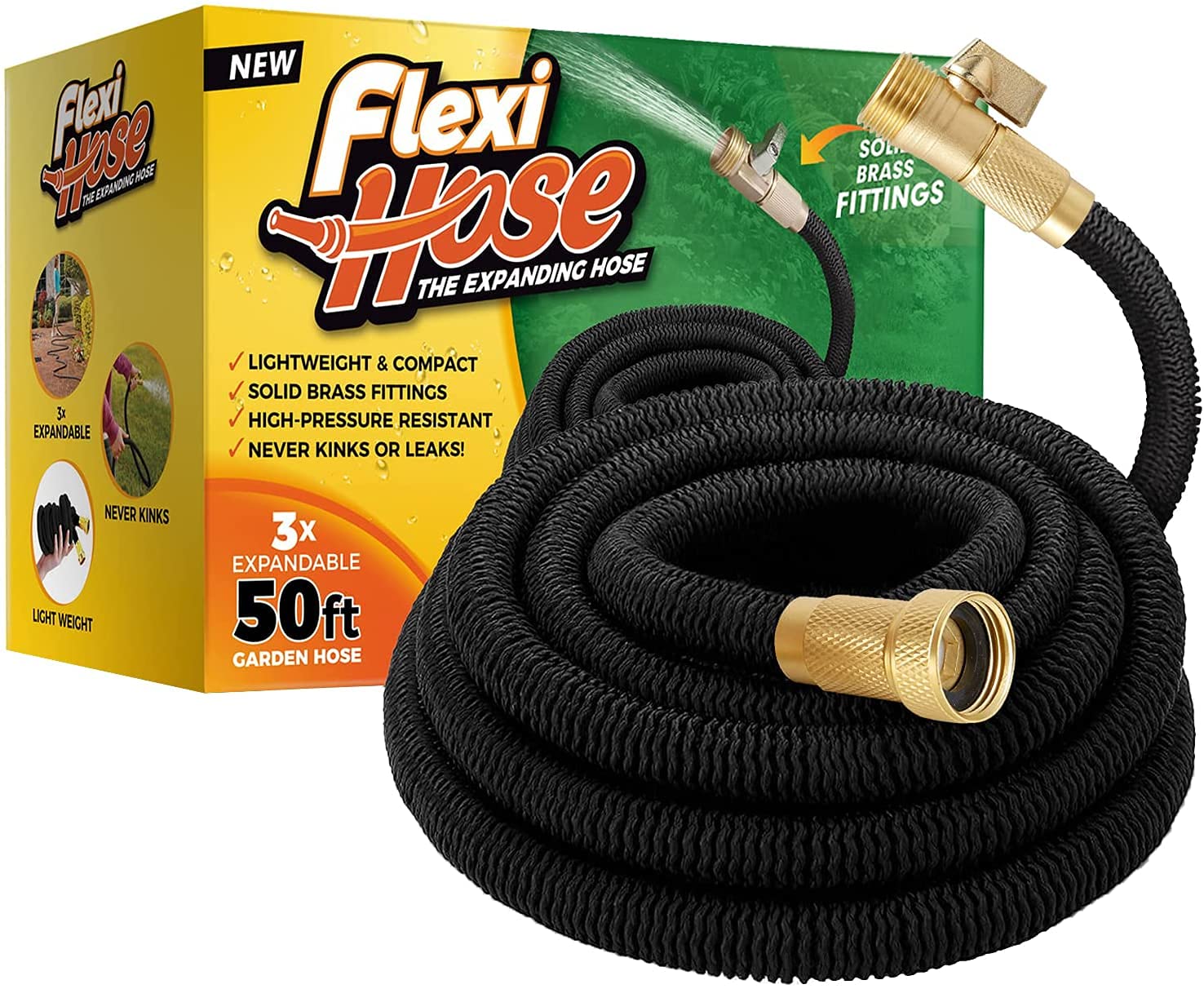
Length: The Flexi Hose expandable garden hose automatically expands up to 50 feet – 3 times its original length – with standard pressure when water is turned on and shortens to its length when the water is turned off for easy hose storage
Materials: Solid 3/4 inch brass connectors ensure the expanding garden water pipe fits the typical outdoor garden taps in the US, but still a lightweight and durable shrinking hose.
Features: Every Flexi Hose is endurance-tested to 2000 uses and can withstand water pressures up to 12 Bar and temperatures between 41 and 113 degrees Fahrenheit.
Pros: Highly rated for its durability and ease of use.
Cons: Some users reported that the hose may not hold up to extremely high water pressure.
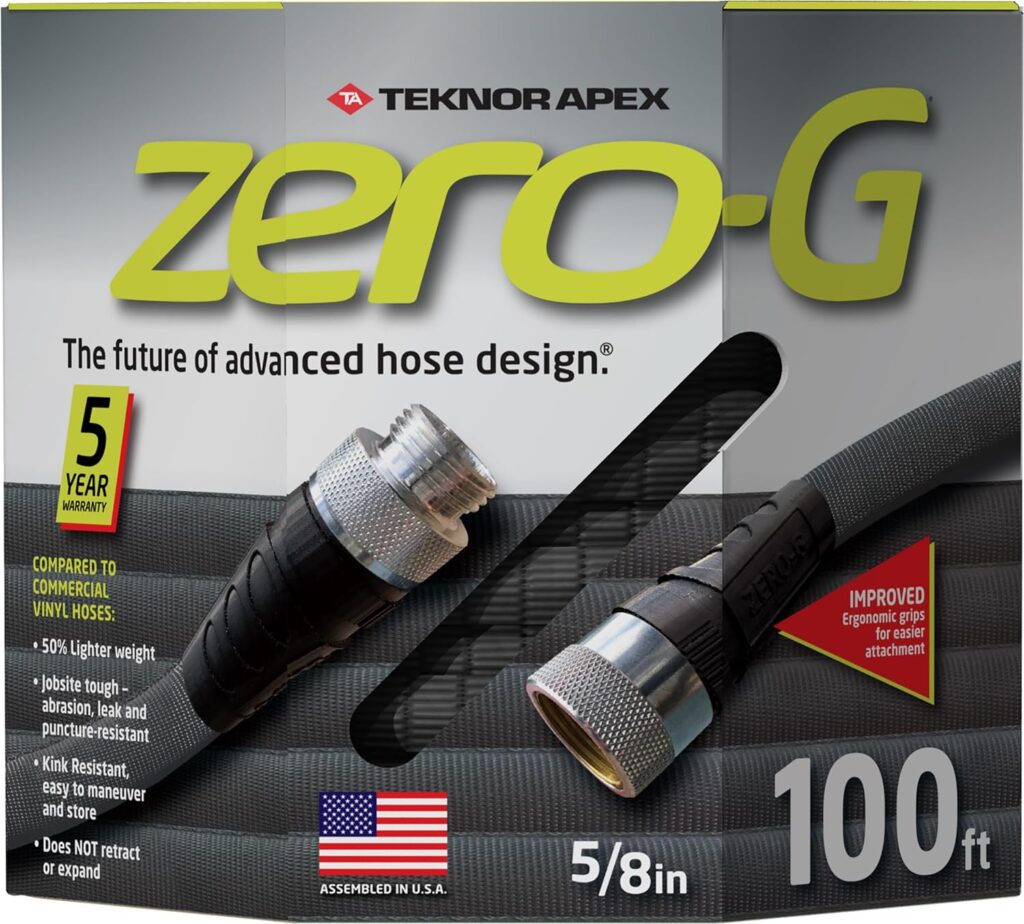
2. Zero-G 4001-50 Lightweight, Ultra Flexible, Durable, Kink-Free Garden Hose
Length: Expands from 33 feet to 100 feet
Materials: Vinyl
Features: Features a high-precision brass connector and a 10-function spray nozzle. It also comes with a lifetime warranty.
Pros: Known for its strength and longevity, ideal for heavy-duty use.
Cons: A bit heavier than some other expandable hoses.
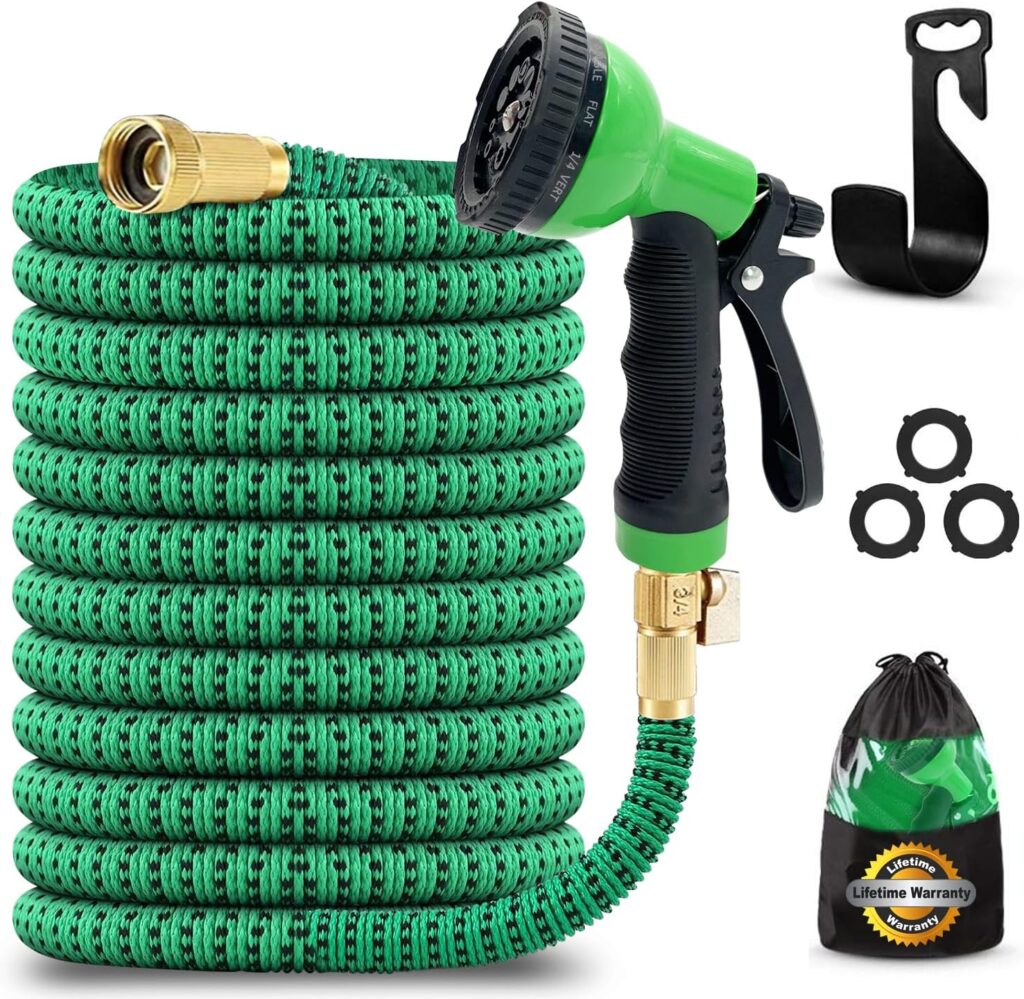
3. J&B XpandaHose 100ft Expandable Garden Hose
Length: Expands from 33 feet to 100 feet
Materials: Made from durable latex, brass and steel.
Features: high quality spray nozzle with 10 adjustable patterns and storage bag. Comes in 3 color choices.
Pros: The hoses are lightweight, maneuverable, expandable. Lifetime warranty, great customer service. Touted as the
Cons: Some users noted that they sprung a leak after 2 or 3 years(company replaced them).
What to Consider When Buying an Expandable Garden Hose
Length: Consider the size of your garden or yard and choose a hose that will reach all the areas you need to water.
Material Quality: Look for hoses made from high-quality materials that are resistant to kinks, abrasions, and punctures.
Connector Type: Solid brass connectors are generally more reliable and long-lasting than plastic ones.
Spray Nozzle Options: A good spray nozzle can offer multiple settings for different watering needs.
Storage: Think about where you will store the hose when not in use. Some hoses come with storage bags or reels, which can be very handy.
***Always read the online reviews when possible. I usually read a few of the highest and the lowest ranking reviews and then base my purchase on that.
Key Takeaways
Expandable garden hoses are a fantastic solution for gardeners who want convenience and ease of use without sacrificing quality. With a variety of options available, you can find the perfect hose to suit your gardening needs. Whether you’re watering your plants, washing your car, or filling up a kiddie pool, an expandable hose can make the task much simpler.
Benefits of using Coiled Garden Hoses


The Coiled Revolution: Transforming Garden Hose Technology
Traditional garden hoses have been a staple in yards and gardens for decades, but they come with their fair share of frustrations. Tangling, kinking, and storage issues have long been the bane of gardeners everywhere.
Coiled garden hoses offer a modern solution designed to address these common problems while introducing new benefits to our outdoor watering routines.
Unraveling the Coiled Concept
Coiled garden hoses maintain a coiled shape even when not in use. This design is a departure from the conventional straight hoses we’re accustomed to seeing sprawled across lawns and driveways.
The coiled structure is typically achieved through the use of memory materials or built-in spring mechanisms that allow the hose to extend when in use and retract back into it’s coiled form when released.
The Space-Saving Superstar
One of the most significant advantages of coiled garden hoses is their compact nature. Maximizing space is crucial, especially for people who have small gardens, patios, or balconies.
When not in use, these hoses take up a fraction of the space compared to their traditional counterparts.
I remember the first time I saw a coiled hose in action at my neighbor’s place. Their tiny urban garden, which was always cluttered with gardening tools, suddenly looked more organized and spacious.
The coiled hose hung neatly on a small hook, taking up minimal space and leaving room for other essentials.
Compact Storage Solutions
Coiled hoses can be easily stored in a variety of ways:
- Wall-mounted hooks: A simple hook on the side of your house or shed can hold the entire hose.
- Portable hose reels: Some manufacturers offer specially designed reels that complement the coiled structure.
- Decorative pots: For a more aesthetic approach, large decorative pots can house the coiled hose while adding to your garden’s decor.
This compact nature makes coiled hoses particularly appealing for:
- Apartment dwellers with limited balcony space
- RV and camper owners
- Boat owners
- Those with small garden sheds or limited garage space
Tangle-Free Triumph
If you’ve ever spent precious gardening time untangling a mess of hose, you’ll appreciate the tangle-free nature of coiled hoses. The coiled design naturally resists tangling and kinking, which saves time and reduces wear and tear on the hose itself.
This feature is particularly useful for those who often move their hose around the garden or need to store it quickly.
The Science Behind Tangle Resistance
The coiled structure creates a natural tension that helps the hose maintain it’s shape. When you pull the hose to use it, it extends smoothly.
When you release it, it naturally wants to return to it’s coiled state.
This self-organizing behavior significantly reduces the chances of tangling.
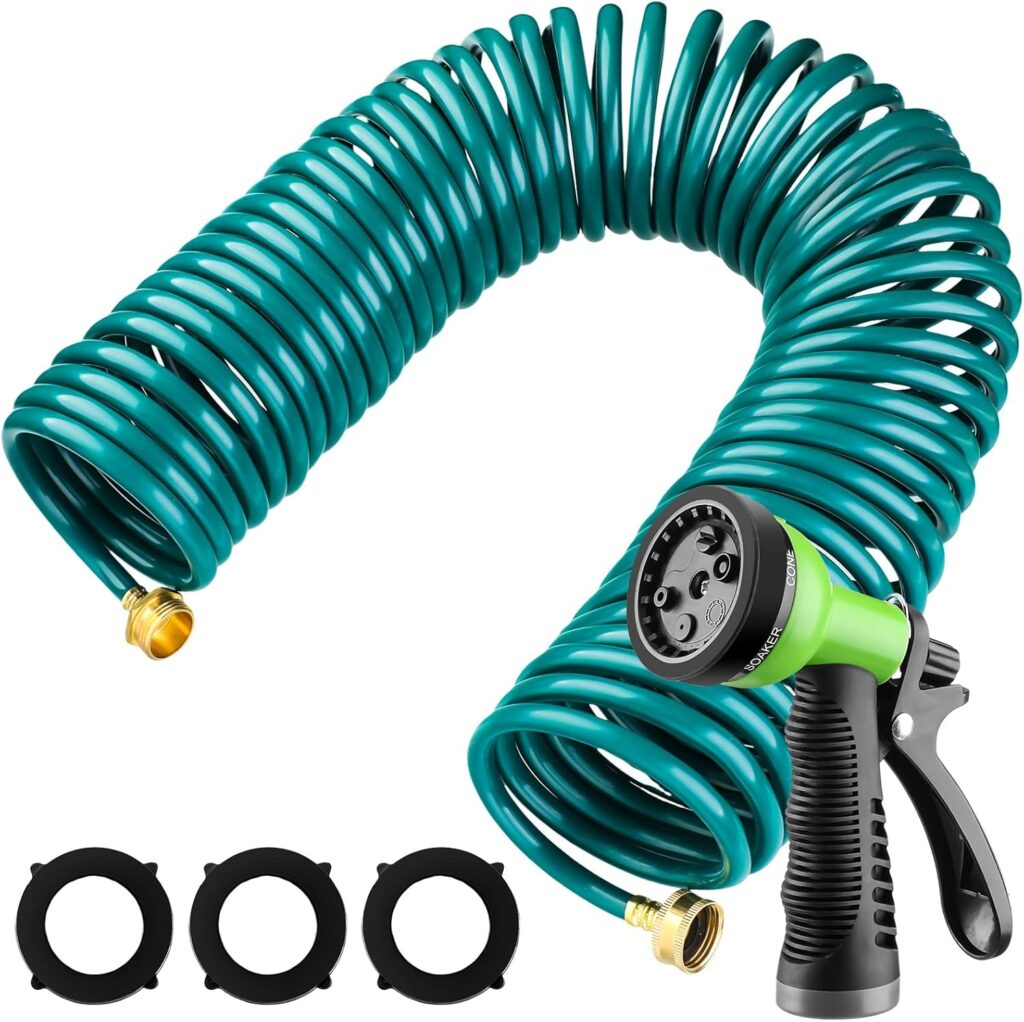
Portability and Versatility
Coiled hoses are typically lightweight and easy to carry, making them ideal for various applications beyond just watering your garden. They’re perfect for:
- RV camping trips: Easily connect to campground water sources without taking up much storage space.
- Washing cars: Move around your vehicle with ease, without dragging a heavy traditional hose.
- Outdoor events: Provide a portable water source for cleaning or drinking water stations.
- Boat maintenance: Lightweight and easy to store on board for quick cleanups.
- For potted plants on patios and decks.
The ability to easily transport and store these hoses opens up a world of possibilities for outdoor water needs. I’ve found them particularly useful for my weekend camping trips, where space is at a premium in my small camper van.
Understanding Extension Ratios
Different brands and models of coiled hoses have varying extension ratios. Some common ratios include:
- 3:1 – A 25-foot coiled hose extends to about 75 feet
- 2:1 – A 25-foot coiled hose extends to about 50 feet
- 1.5:1 – A 25-foot coiled hose extends to about 37.5 feet
When shopping for a coiled hose, pay attention to these ratios to confirm you’re getting a product that meets your reach requirements.
Durability Dilemma
While many coiled hoses are designed to be durable, the constant extension and retraction can put stress on the material over time. High-quality coiled hoses are made with materials that can withstand this repeated action, but lower-quality options may wear out faster than traditional hoses.
I’ve found that investing in a reputable brand with good reviews can make a significant difference in the longevity of a coiled hose. It’s one of those cases where spending a bit more upfront can save money and frustration in the long run.

2. Therwen 75.5 ft Heavy Duty EVA Recoil Garden Hose
Materials Matter
The durability of a coiled hose largely depends on the materials used in it’s construction. Some common materials include:
- Polyurethane: Highly durable and resistant to kinking, but can be more expensive.
- Latex: Flexible and durable, with good resistance to temperature extremes.
- PVC: Less expensive but may not be as durable as other options.
- TPE (Thermoplastic Elastomer): A newer material that offers a good balance of flexibility and durability.
When choosing a coiled hose, look for reinforced construction, such as multiple layers or a mesh outer layer, which can significantly improve durability.
Nozzle Compatibility and Accessories
When choosing a coiled hose, it’s important to consider compatibility with existing nozzles and sprayers. Most coiled hoses come with standard fittings, but it’s always worth double-checking to confirm they’ll work with your current setup.
Some manufacturers offer specialized nozzles designed to complement the coiled structure, which can enhance the overall user experience.
Key Takeaways
Coiled garden hoses offer a space-saving, tangle-free alternative to traditional hoses, ideal for small spaces and portable use. They provide good durability and weather resistance when well-made, but may have slightly reduced water pressure and reach compared to straight hoses. While they need some adaptation, their benefits in storage and handling make them a worthy consideration for many gardeners and homeowners.

3. Water Right 300 Series (3/8″) Coil Garden Hose, Drinking Water Safe.
Metal Garden Hoses: A Comprehensive Guide to Their Pros and Cons

As an avid gardener, I’ve always been on the lookout for tools that can make my green-thumbed pursuits more effective and enjoyable. When metal garden hoses first appeared on the market, I was immediately intrigued by their sleek appearance and promises of durability.
After extensive use and research, I’m excited to share my insights on the benefits and drawbacks of these innovative watering tools.
The Evolution of Garden Hoses
Garden hoses have come a long way since their inception. Traditional rubber and plastic hoses have been staples in gardens for decades, serving us well but often falling short in terms of durability and convenience.
The introduction of metal garden hoses marks a significant step forward in addressing many of the common frustrations gardeners face with conventional hoses.
These hoses, typically made from stainless steel, have gained popularity because of their unique properties and potential advantages over traditional options. But are they truly the game-changer they claim to be?
Let’s explore the pros and cons to help you decide if a metal garden hose is right for your green space.
Pros of Metal Garden Hoses
1. Unmatched Durability
One of the most significant advantages of metal garden hoses is their exceptional durability. The stainless steel construction makes them incredibly resistant to punctures, tears, and abrasions.
I’ve dragged my metal hose across rough concrete, gravel, and even thorny bushes without a single scratch or leak.
This robustness means you won’t have to replace your hose as often as you might with rubber or plastic choices. The durability factor extends beyond just physical damage.
Metal hoses are also resistant to UV rays, which can cause traditional hoses to degrade and crack over time.
This means your metal hose can withstand prolonged exposure to sunlight without compromising it’s integrity.
In my experience, this durability has translated to significant cost savings over time. While the initial investment may be higher, I’ve found that my metal hose has outlasted several traditional hoses, making it a more economical choice in the long run.
2. Kink-Free Design
If you’ve ever battled with a kinked hose while watering your plants, you’ll appreciate the kink-free nature of metal garden hoses. The rigid structure of the metal prevents the hose from bending and twisting, ensuring a consistent water flow.
This feature saves time and frustration and helps maintain the integrity of the hose over time.
I’ve found this particularly useful when working in larger gardens or when I need to navigate around obstacles. No more stopping to unkink the hose every few minutes – just smooth, uninterrupted watering from start to finish.
This has significantly improved my efficiency in the garden, allowing me to finish watering tasks more quickly and with less frustration.
The kink-free design also contributes to the longevity of the hose. Traditional hoses often develop weak spots at kink points, leading to eventual leaks or bursts.
With a metal hose, this issue is virtually eliminated, further enhancing it’s durability.
3. Weather Resistance
Metal garden hoses excel in various weather conditions. They’re freeze-resistant, allowing you to leave them outdoors during colder months without worrying about damage.
This all-season durability is a significant advantage for gardeners in diverse climates.
I’ve left my metal hose out through scorching summers and frosty winters, and it’s performed admirably in both extremes. This resilience adds to the hose’s longevity and saves me the hassle of seasonal storage and maintenance.
In regions with extreme temperature fluctuations, this feature can be particularly valuable, as it eliminates the need to constantly bring the hose indoors or worry about it cracking in freezing temperatures.
Plus, the metal construction resists degradation from prolonged sun exposure, a common issue with rubber and plastic hoses. This UV resistance confirms that your hose maintains it’s integrity and appearance even after years of outdoor use.
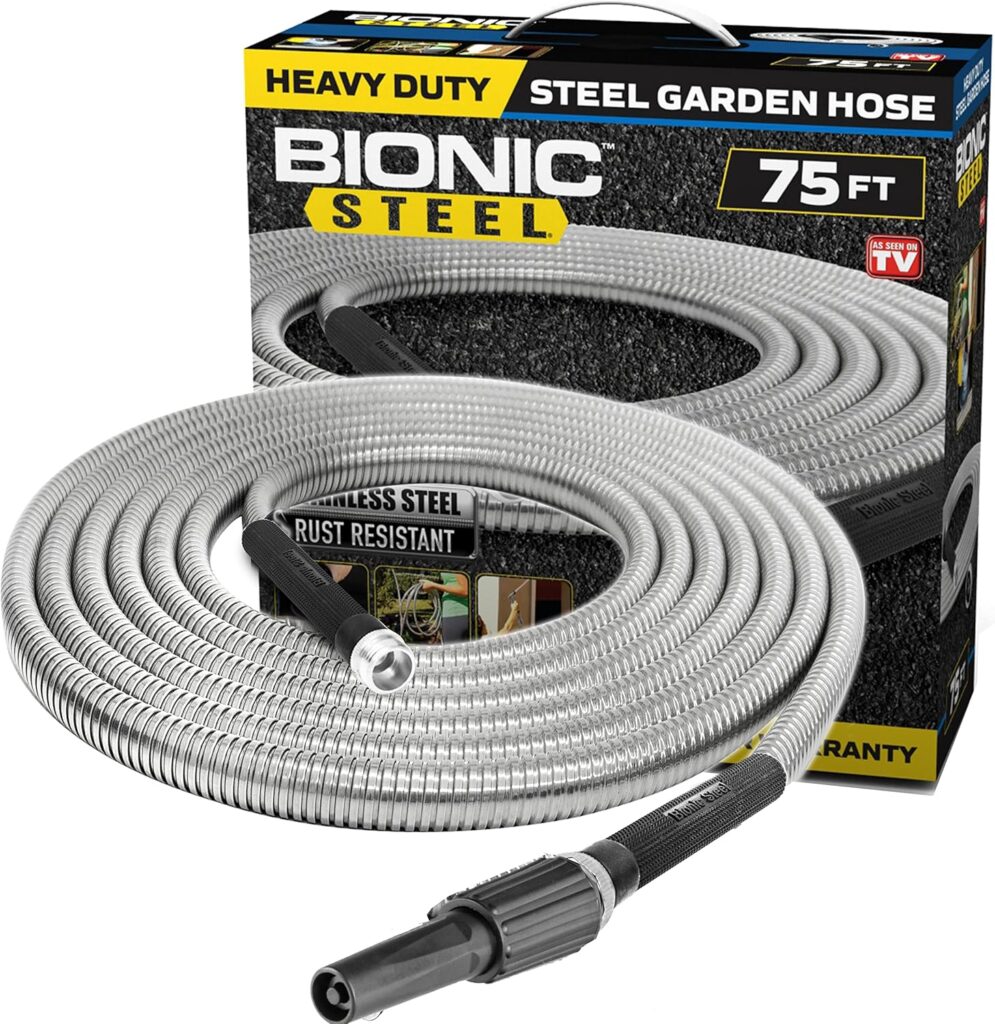
1.Bionic Steel 75 Foot Garden Hose 304 Stainless Steel Metal
4. Tangle-Proof and Easy to Store
The flexible yet sturdy nature of metal hoses makes them incredibly easy to maneuver and store. They don’t tangle like traditional hoses, and their lightweight design allows for effective coiling.
Many metal hoses come with a self-coiling feature, further simplifying storage and reducing clutter in your garden or garage.
I’ve found this particularly useful in my small urban garden, where space is at a premium. The ability to neatly coil and store my hose without it becoming a tangled mess has been a game-changer for my garden organization.
The self-coiling feature means I can quickly wrap up the hose after use, keeping my garden tidy and preventing tripping hazards.
Additionally, the compact storage of metal hoses makes them ideal for people who have limited space. Whether you’re dealing with a small balcony garden or a crowded tool shed, the effective storage of a metal hose can be a significant advantage.
5. Pet-Proof and Chew-Resistant
For those of us with curious pets or wildlife visitors, metal garden hoses offer peace of mind. Unlike rubber hoses that can be easily chewed through, the stainless steel exterior is virtually indestructible.
This feature protects your investment and prevents potential harm to animals that might be tempted to nibble on a traditional hose.
As a dog owner, I’ve seen firsthand how a playful dog can turn a regular garden hose into a chew toy. With my metal hose, I no longer worry about coming home to a yard flooded by a punctured hose.
This chew-resistance also makes metal hoses a great choice for areas where wildlife might be tempted to gnaw on garden equipment.
The durability against animal interference extends the life of your hose and confirms consistent performance. You won’t have to deal with unexpected leaks or reduced water pressure because of small punctures or tears caused by curious critters.
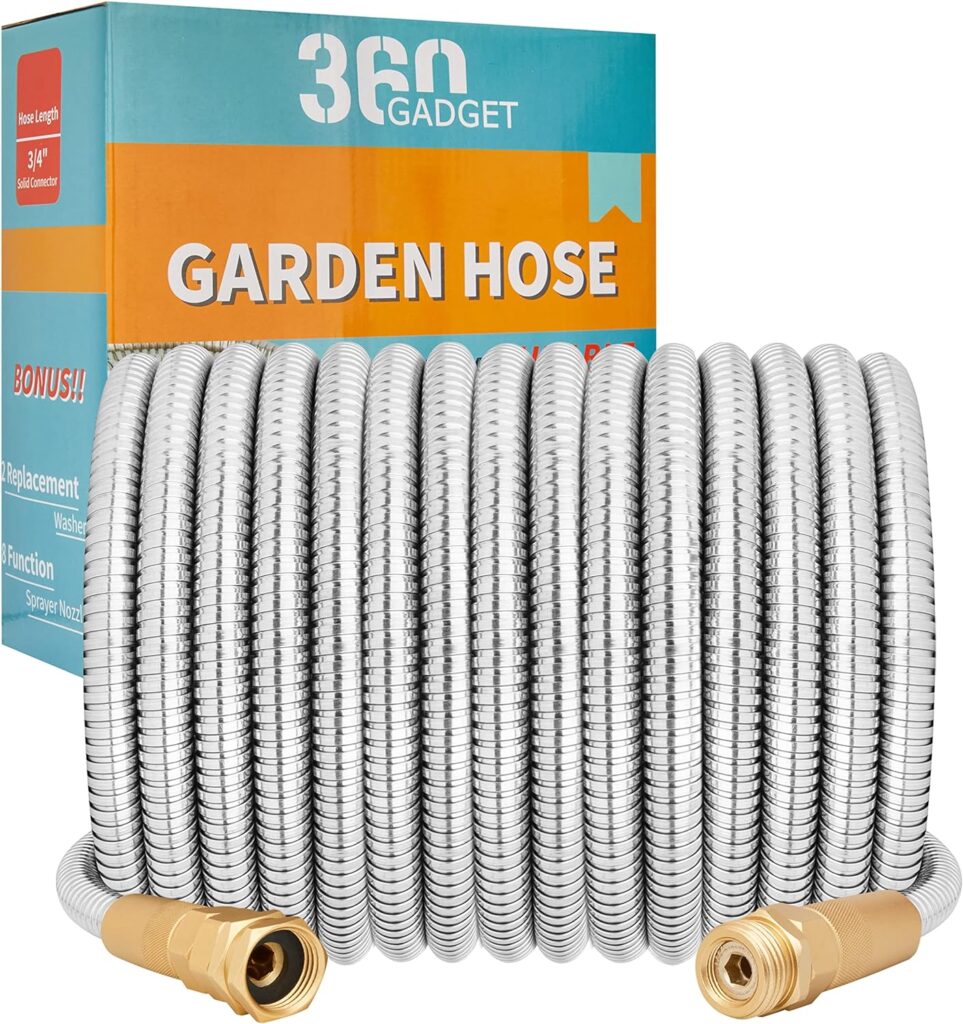
2. Garden Hose Metal – 50ft Heavy Duty Stainless Steel Water Hose with 8 Function Sprayer
Cons of Metal Garden Hoses
While metal garden hoses offer many benefits, it’s essential to consider their potential drawbacks before making a purchase. Let’s explore some of the limitations I’ve encountered during my use of these innovative watering tools.
1. Higher Initial Cost
One of the most significant disadvantages of metal garden hoses is their price point. They typically cost more than traditional rubber or plastic hoses.
This higher upfront investment can be a deterrent for budget-conscious gardeners or those who aren’t sure if they’ll benefit from the unique features of a metal hose.
However, it’s important to consider the long-term value. The durability and longevity of metal hoses may offset the initial investment over time, as you’ll likely need to replace them less often.
In my experience, the cost has been justified by the hose’s performance and durability, but it’s a factor that each gardener will need to weigh based on their person needs and budget.
When considering the cost, factor in potential savings from not having to replace your hose as often. Also, consider the value of time saved from dealing with kinks, tangles, and storage issues that are common with traditional hoses.
2. Potential for Extreme Temperatures
While metal hoses are generally weather-resistant, they can become uncomfortably hot when left in direct sunlight for extended periods. This heat retention can make handling the hose challenging and potentially dangerous.
On the flip side, in very cold temperatures, the metal can become extremely cold to touch, which might be uncomfortable for bare hands.
I’ve learned to be cautious when using my metal hose on particularly hot or cold days, often wearing gloves to protect my hands. While this isn’t a deal-breaker, it’s something to be aware of, especially if you live in an area with extreme temperatures.
To mitigate this issue, you can store the hose in a shaded area when not in use or use insulated gloves when handling it in extreme temperatures. Some gardeners also find it helpful to run water through the hose for a few moments before handling it to regulate it’s temperature.
3. Limited Flexibility
Although the rigid structure of metal hoses prevents kinking, it also means they’re less flexible than their rubber counterparts. This reduced flexibility can make it more challenging to navigate tight corners or wrap around obstacles in your garden.
If you have a complex garden layout with many twists and turns, a metal hose might not be the most practical choice.
In my own garden, I’ve found that while the metal hose works great for straight runs and open spaces, it can be a bit cumbersome when trying to water plants in tight or awkward spots. It’s a trade-off between kink-free operation and maneuverability that each gardener will need to consider based on their garden’s layout.
To work around this limitation, you might need to use extra attachments or nozzles to reach difficult areas. Alternatively, you could consider keeping a shorter, more flexible hose on hand for those hard-to-reach spots while using the metal hose for the majority of your watering needs.
4. Weight Considerations
While many metal hoses are marketed as lightweight, they can still be heavier than traditional rubber hoses, especially in longer lengths. This added weight might be a concern for elderly gardeners or those with limited strength.
It’s essential to consider the weight of the hose when fully filled with water, as this can significantly impact maneuverability.
I’ve noticed that after extended watering sessions, the weight of my metal hose can become noticeable. While it hasn’t been a major issue for me, it’s something to keep in mind, especially if you have a large garden that needs a longer hose.
To address this, consider opting for a shorter length if possible, or look for models that specifically emphasize lightweight construction. Some gardeners find it helpful to use a hose reel or cart to assist with moving and storing heavier hoses.
5. Potential for Scratching Surfaces
The metal exterior of these hoses, while durable, can potentially scratch delicate surfaces if dragged carelessly. This might be a concern if you have expensive patio furniture, delicate decking, or painted surfaces in your outdoor area.
Extra care may be needed when using the hose around these items.
I’ve had to be more mindful of how I move my metal hose around my garden furniture and wooden deck. While it hasn’t caused any significant damage, I’m always aware of the potential for scratches and take precautions to avoid any issues.
To minimize the risk of scratches, you can use hose guides or rollers at key points in your garden to keep the hose off sensitive surfaces. Additionally, being mindful of how you handle the hose and avoiding dragging it across delicate areas can go a long way in preventing any damage.
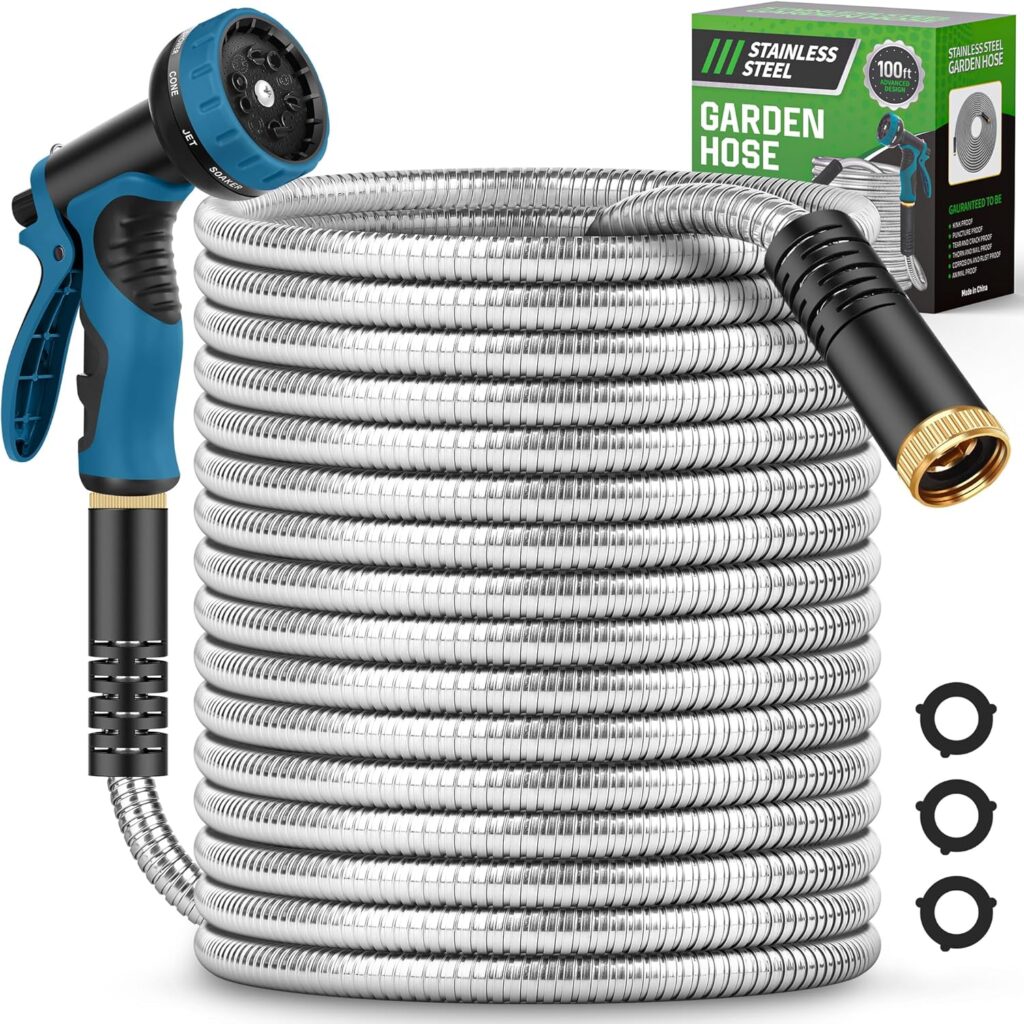
3. Garden Hose 100FT, Water Hose with 10 Function Nozzle, Garden Hose Metal with Leak-proof Connectors
Making the Right Choice for Your Garden
When deciding whether a metal garden hose is right for you, consider your specific needs and gardening habits. If durability, kink-resistance, and easy storage are your top priorities, a metal hose could be an excellent investment.
However, if you prioritize flexibility or have a tight budget, a traditional rubber hose might still be the better option.
Consider the following factors when making your decision:
- Garden size and layout: Metal hoses work best in open spaces with fewer obstacles.
If your garden has many tight corners or delicate plants, a more flexible hose might be preferable.
- Climate: If you live in an area with extreme temperatures, be prepared to take extra precautions when handling a metal hose.
- Storage space: Metal hoses are excellent for people who have limited storage because of their compact coiling ability.
- Budget: While more expensive upfront, metal hoses can be cost-effective in the long run because of their durability.
- Physical capabilities: Consider the weight of the hose, especially if you have any physical limitations.
- Pets and wildlife: If you have animals that tend to chew on hoses, a metal hose could be a great solution.
Tips for Using Metal Garden Hoses
If you decide to give metal garden hoses a try, here are some pro tips to maximize their benefits:
- Use gloves: When handling the hose in extreme temperatures, wear gloves to protect your hands from heat or cold.
- Invest in proper storage: A hose reel or hanger specifically designed for metal hoses can improve storage and extend the life of your hose.
- Be mindful of surfaces: Pay attention to the hose’s path to avoid potential scratching of delicate surfaces like wooden decks or patio furniture.
- Consider length carefully: If weight is a concern, consider purchasing a shorter length for easier maneuverability.
- Look for ergonomic features: Models with ergonomic grips and high-quality fittings can enhance usability and comfort.
- Use hose guides: Implement hose guides or rollers in your garden to protect plants and surfaces from potential damage.
- Regular maintenance: While metal hoses need less maintenance than traditional ones, occasional cleaning and checking of fittings can confirm optimal performance.
- Proper winter care: Even though metal hoses are freeze-resistant, it’s still a good idea to drain them before storing for winter in extremely cold climates.
- Combine with traditional hoses: Consider keeping a short, flexible rubber hose on hand for areas where the metal hose’s rigidity might be a hindrance.
- Experiment with attachments: Various nozzles and sprayers can enhance the functionality of your metal hose, allowing you to tackle different watering tasks more efficiently.
The Future of Garden Hoses
As technology advances, we’re likely to see further innovations in garden hose design. Metal hoses represent a significant step forward in addressing common hose-related frustrations.
While they may not be perfect for every situation, they offer a durable, effective, and low-maintenance option for many gardeners.
We might see developments such as:
- Improved insulation: Future metal hoses could incorporate better insulation to address temperature-related handling issues.
- Enhanced flexibility: Manufacturers may find ways to increase the flexibility of metal hoses without compromising their kink-free nature.
- Smart features: Integration with smart home systems could allow for automated watering schedules and water usage tracking.
- Eco-friendly materials: As sustainability becomes increasingly important, we might see metal hoses made from recycled materials or designed for easier recycling at the end of their life cycle.
- Hybrid designs: Combinations of metal and other materials could offer the best of both worlds, balancing durability with flexibility.
Frequently Asked Questions
Are metal garden hoses worth the money?
Metal garden hoses can be a worthwhile investment for many gardeners because of their durability, kink-resistance, and ease of storage. While they have a higher upfront cost, their longevity often makes them cost-effective in the long run.
How long do metal garden hoses last?
With proper care, metal garden hoses can last significantly longer than traditional rubber or plastic hoses. Many users report their metal hoses lasting 5-10 years or more, compared to 2-3 years for standard hoses.
Can metal garden hoses freeze?
While metal garden hoses are more resistant to freezing than traditional hoses, they can still be damaged in extreme cold. It’s best to drain and store them properly in freezing temperatures.
Are metal garden hoses safe for drinking water?
Most metal garden hoses are not designed for drinking water. Always check the manufacturer’s specifications and look for hoses specifically labeled as safe for potable water if this is a concern.
Do metal garden hoses get hot in the sun?
Yes, metal garden hoses can become hot when exposed to direct sunlight for extended periods. It’s advisable to wear gloves or allow the hose to cool before handling in hot weather.
Can you repair a metal garden hose?
While metal garden hoses are highly durable, they can occasionally develop leaks, usually at the fittings. Many can be repaired using replacement fittings or connectors, but severe damage may need replacing the entire hose.
Are metal garden hoses lighter than rubber hoses?
Metal garden hoses are often comparable in weight to traditional rubber hoses when dry. However, they can feel heavier when filled with water, especially in longer lengths.
Do metal garden hoses work with standard fittings and nozzles?
Most metal garden hoses are designed to be compatible with standard garden hose fittings and nozzles. Always check the specifications to confirm compatibility with your existing equipment.
Can metal garden hoses be left outside year-round?
While metal garden hoses are more weather-resistant than traditional hoses, it’s still best to store them in a protected area during harsh weather conditions to maximize their lifespan.
Are there different types of metal garden hoses?
Yes, there are variations in metal garden hoses, including differences in the type of metal used, the construction of the inner lining, and extra features like self-coiling mechanisms or specialized coatings.
Key Takeaways
Metal garden hoses offer a durable, kink-free choice to traditional rubber or plastic hoses. They excel in longevity, ease of storage, and resistance to damage from pets or wildlife.
However, they come with considerations such as higher initial cost, potential temperature-related handling issues, and less flexibility compared to traditional hoses.
The decision to invest in a metal garden hose should be based on your specific gardening needs, budget, and preferences. While they may not be the perfect solution for every gardener, many users find that the benefits outweigh the drawbacks, especially in terms of long-term durability and ease of use.
As with any gardening tool, proper care and maintenance will help you get the most out of your metal garden hose. By understanding both the advantages and limitations of these innovative watering tools, you can make an informed decision about whether a metal garden hose is the right choice for your green space.
Hose Guides: The Unsung Heroes of Garden Maintenance
Gardening enthusiasts often focus on plants, soil quality, and watering techniques, but there’s an essential tool that deserves more recognition: the humble hose guide. These small accessories play a crucial role in garden maintenance, offering both practical benefits and aesthetic appeal.
The Practical Side: Heavy-Duty Hose Guides
Functionality at Its Finest
Heavy-duty hose guides are the workhorses of garden accessories. Their primary function is to direct your garden hose around corners, protect delicate plants from being crushed, and prevent damage to lawn edges.
These guides are typically made from durable materials such as steel, cast iron, or high-grade plastics, ensuring they can withstand constant pressure, movement, and various weather conditions.
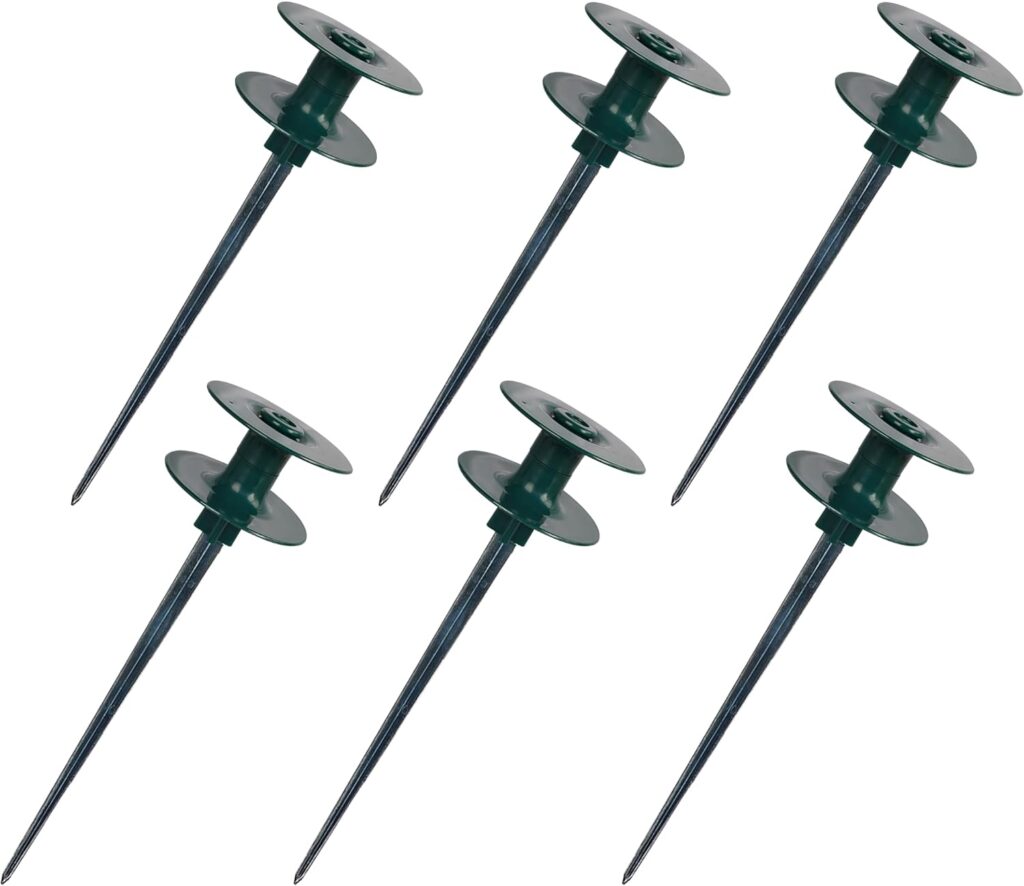
Hourleey 6 Pack Garden Hose Guide Spike, 10 Inch Rustproof Zinc Sturdy Metal Stake
Adding Personality to Your Garden
While functionality is important, garden accessories can also be an opportunity to express your personal style. Decorative hose guides offer the perfect blend of practicality and personality for your outdoor space.
These guides come in a wide variety of designs, from cute animal shapes to elegant metalwork, allowing you to add character to your garden while still serving a practical purpose.
Transforming Mundane into Marvelous
Here’s a line of whimsical shapes. These decorative guides can transform a basic gardening tool into a charming garden feature. They’re particularly great for front yards or visible areas of your garden where you want to maintain a polished, decorative look.

Garden Hose Guide Stake, 5PCS Garden Hose Spike Lawn Hose Support Spikes
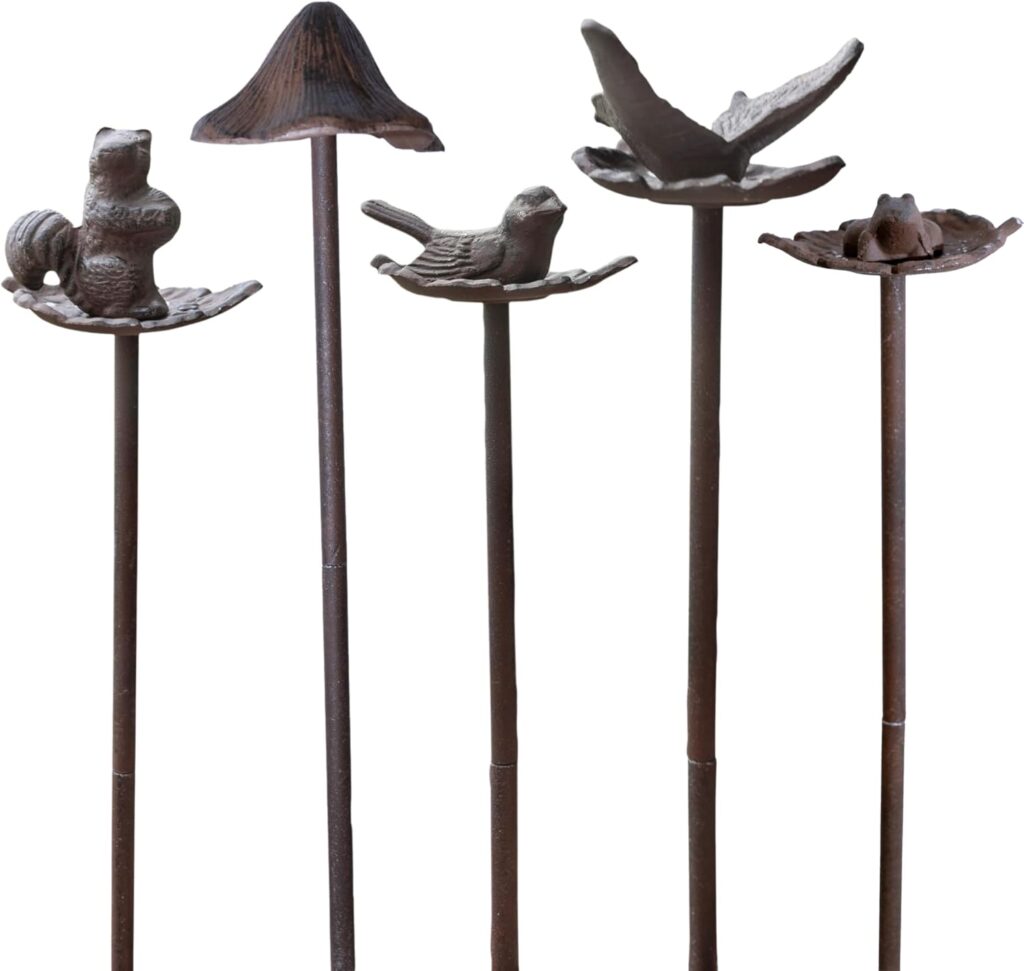
Hose Guide Set – Set of 5 Heavy Duty Solid Aluminum Decorative Garden Hose Stakes
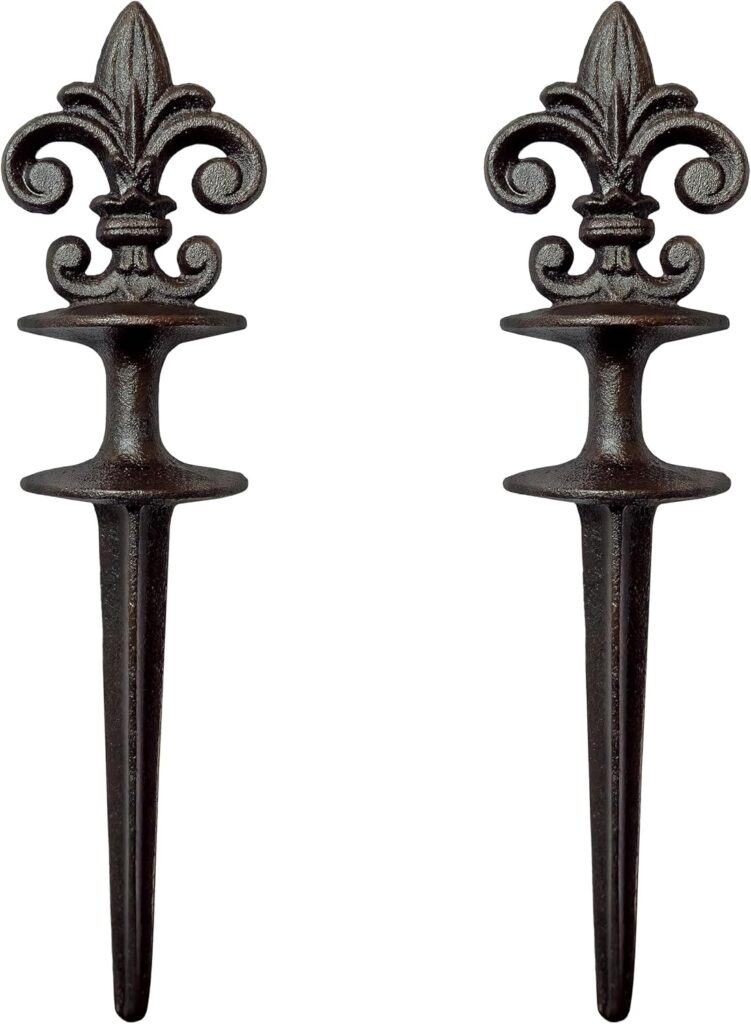
Lulu Decor, Antique Black Cast Iron Garden Fleur de lis Hose Guides, Set of 2